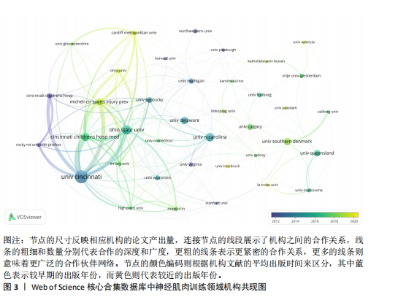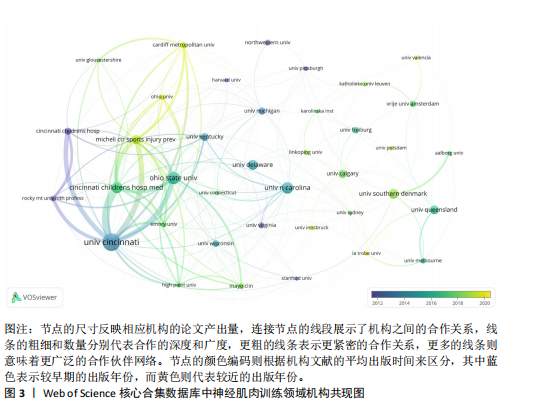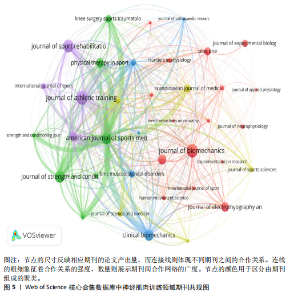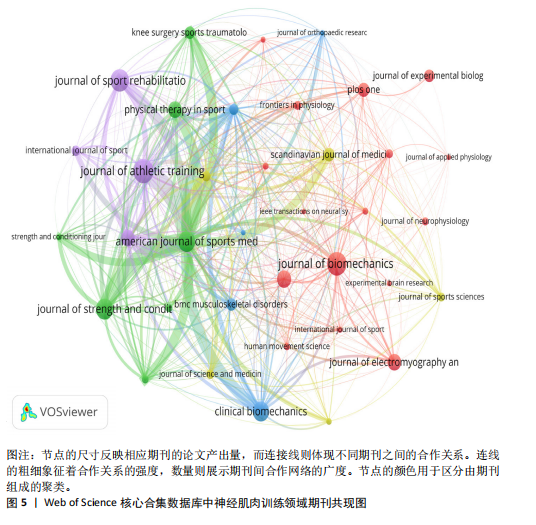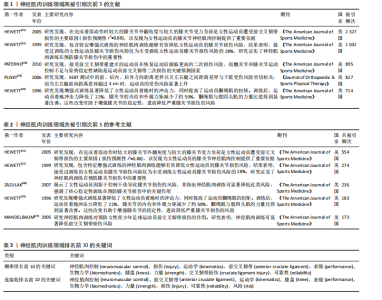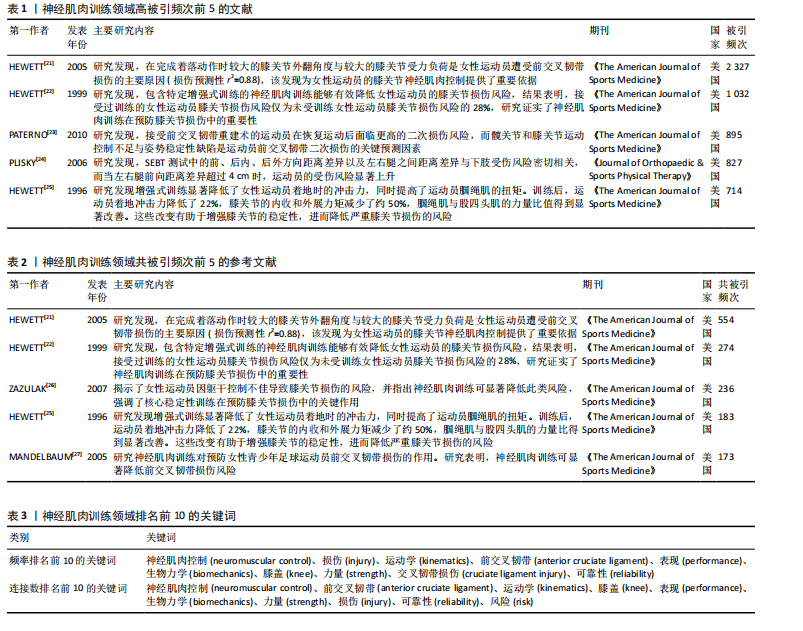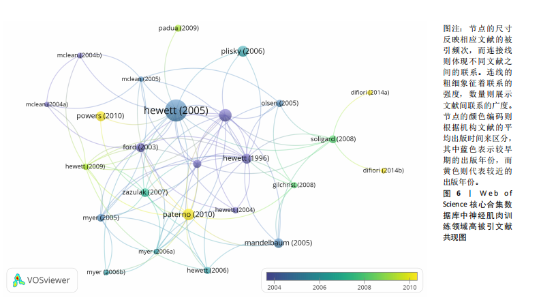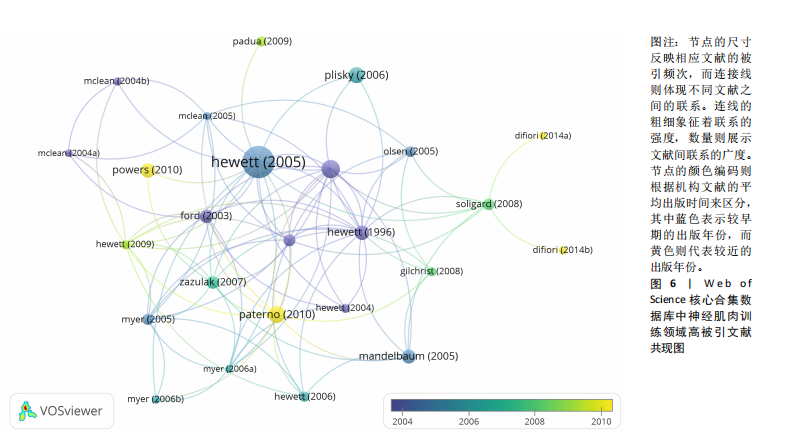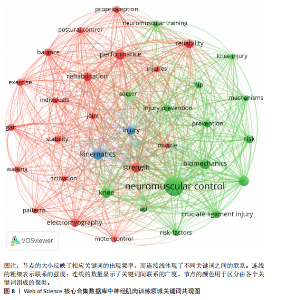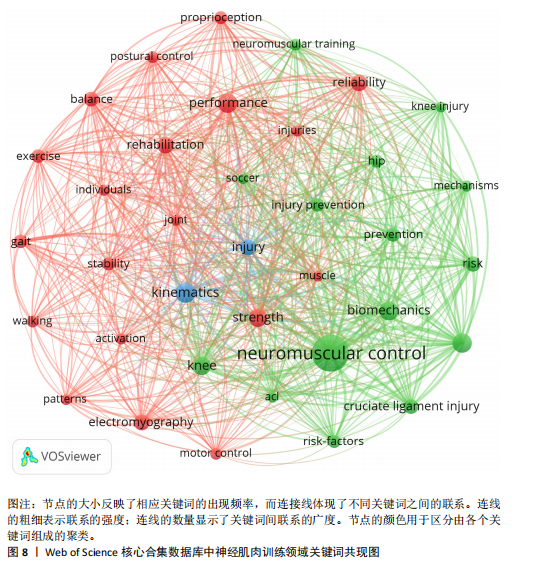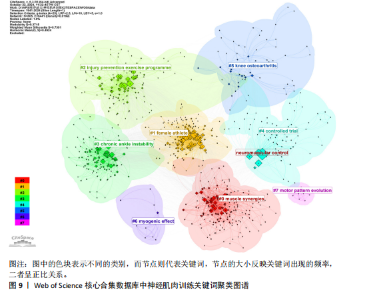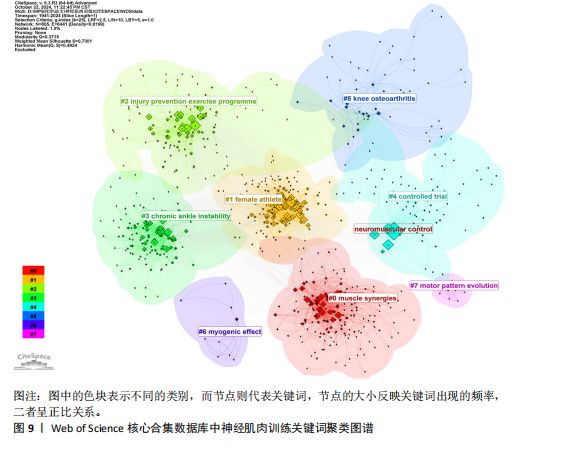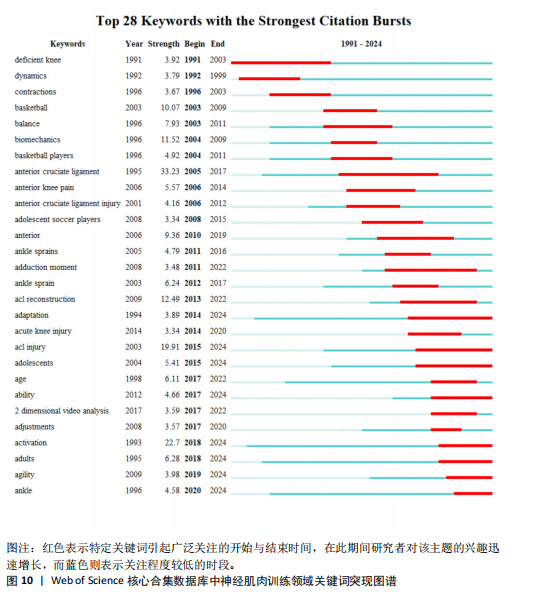Chinese Journal of Tissue Engineering Research ›› 2025, Vol. 29 ›› Issue (24): 5148-5157.doi: 10.12307/2025.735
Previous Articles Next Articles
Research hotspots, frontier changes, and trend prospects of neuromuscular training
Tian Hao1, Chen Dingding1, Wang Deng2, Ye Qiang1
- 1Nanjing Sport Institute, Nanjing 210000, Jiangsu Province, China; 2Polytechnic University of Madrid, Madrid 28040, Spain
-
Received:2024-08-28Accepted:2024-11-02Online:2025-08-28Published:2025-01-24 -
Contact:Ye Qiang, PhD, Professor, Nanjing Sport Institute, Nanjing 210000, Jiangsu Province, China -
About author:Tian Hao, MS, Assistant teacher, Nanjing Sport Institute, Nanjing 210000, Jiangsu Province, China -
Supported by:Ministry of Education Humanities and Social Science Fund Project, No. 19YJA890032 (to YQ); 2022 General Project of Philosophy and Social Science Research in Colleges and Universities, No. 2022SJYB0384 (to TH); 2023 Research Project of Educational Informatization in Colleges and Universities in Jiangsu Province, No. 2023JSETKT113 (to TH); 2023 School-level Educational Reform Research Project of Nanjing Sport Institute, No. JG202336 (to TH)
CLC Number:
Cite this article
Tian Hao, Chen Dingding, Wang Deng, Ye Qiang. Research hotspots, frontier changes, and trend prospects of neuromuscular training[J]. Chinese Journal of Tissue Engineering Research, 2025, 29(24): 5148-5157.
share this article
Add to citation manager EndNote|Reference Manager|ProCite|BibTeX|RefWorks
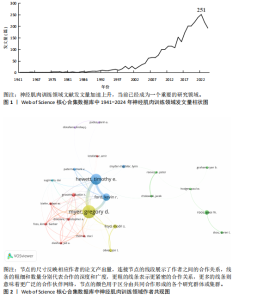
2.1 检索结果与文献特征 回溯神经肌肉训练相关研究发展历程(图1),自20世纪40年代起有学者开始关注,从20世纪90年代初开始起步,进入21世纪相关研究开始稳步增长,2018年起每年发文均超过200篇,到2022年达到了年发文251篇,神经肌肉训练目前已成为重要的研究领域。 2.2 主要学者分析 神经肌肉训练领域共有9 741位作者,根据普赖斯定律中核心作者计算公式[20],核心作者中最低发文量M=7.856,约为8篇。有99位核心作者发文量≥8篇,其中35位核心作者的发文量≥13篇(图2)。分析结果表明神经肌肉训练研究领域已形成显著的核心作者团队,该团队以Gregory D. Myer(美国埃默里大学运动表现和研究中心)、Timothy Edwin Hewett(美国马歇尔大学医学院)、Kevin R. Ford(美国海波因特大学)为核心,是目前该领域成果最显著、合作最紧密的研究团队。Gregory D. Myer(110篇,美国埃默里大学运动表现和研究中心)、Timothy Edwin Hewett(81篇,美国马歇尔大学医学院)、Kevin R. Ford(52篇,美国马歇尔大学医学院)、Ewa M. Roos(30篇,美国马歇尔大学医学院)和Rhodri Lloyd(27篇,美国马歇尔大学医学院)是发文量排名前5的学者。 2.3 主要机构分析 神经肌肉训练领域的研究共涉及2 927个机构,有38个机构的发文量≥23篇(图3)。结果表明国际上已有大量机构参与该领域研究,且机构之间存在频繁的合作。与其他机构连接最广泛的机构是辛辛那提大学(美国,连接数:509),其次是米凯利运动损伤预防中心(美国,连接数:338)、辛辛那提儿童医院医疗中心(美国,连接数:336)、俄亥俄州立大学(美国,连接数:254)、卡迪夫都市大学(英国,连接数:181)。发文量最多的5个机构分别是:辛辛那提大学(125篇)、俄亥俄州立大学(82篇)、北卡罗来纳大学(76篇)、辛辛那提儿童医院医疗中心(74篇)、南丹麦大学(63篇)。 2.4 主要国家分析 神经肌肉训练领域共涉及76个国家,有36个国家的发文量≥14篇(图4),其中美国(连接数:457)与其他国家联系最广泛,其次是英国(连接数:271)、澳大利亚(连接数:242)、加拿大(连接数:175)、德国(连接数:141)。美国是神经肌肉训练领域最高产的国家,发文量为1 303篇,占所有纳入文献的42%,处于较为明显的垄断地位,其次较为活跃的国家包括加拿大(232篇)、澳大利亚(229篇)、英国(224篇)和中国(190篇)。 2.5 主要来源期刊分析 神经肌肉训练领域涉及的期刊共有635本,有37本期刊的发文量≥20篇(图5),在神经肌肉训练领域中,期刊内容涉及运动科学、骨科、神经科学、工程生物医学等多个学科,研究问题主要聚焦于前交叉韧带、足球、脚踝损伤、腰痛和跌倒等主题。与其他期刊联系最广泛的期刊是《American Journal of Sports Medicine》(连接数:2 512),在行业内具备不可或缺的影响力,其次是《Journal of Athletic Training》(连接数:963)、《Journal of Orthopaedic & Sports Physical Therapy》(连接数:827)、 《Journal of Strength And Conditioning Research》(连接数:783)和《Clinical Biomechanics》(连接数:61)。而《Journal of Athletic Training》(85篇)发文量最多,其次是《Journal of Biomechanics》(83篇),《Journal of Sport Rehabilitation》(79篇)、《Journal of Strength And Conditioning Research》(74篇)和《American Journal of Sports Medicine》(72篇)。"
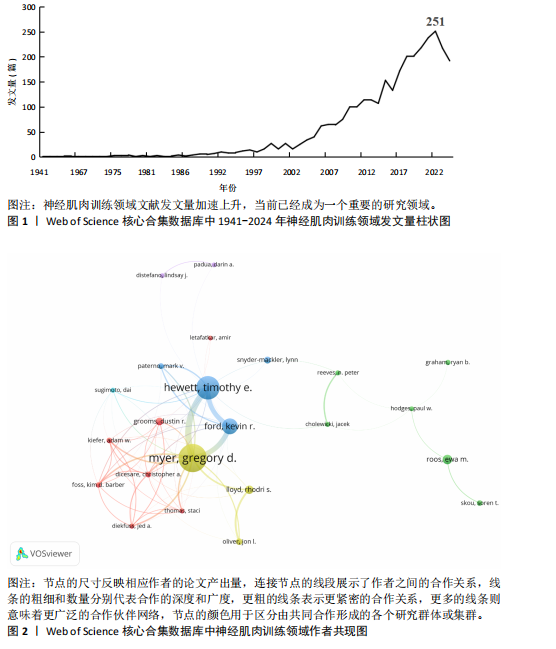
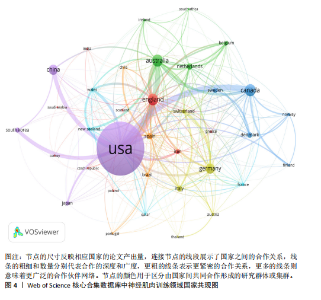
2.6 被引文献分析 神经肌肉训练领域有3 102篇文献,有38篇文献的被引频次≥290次(图6)。其中,被引频次最高的文献为Hewett(2005)[21],被引频次高达2 327次,其次为Hewett(1999)[22]、Paterno(2010)[23]、Plisky(2006)[24]、Hewett(1996)[25] (表1)。 2.7 参考文献共被引分析 神经肌肉训练领域共有6 742条共被引的参考文献,有35篇文献的共被引频次≥77次(图7)。可视化分析可见,神经肌肉训练领域共被引参考文献数量繁多,参考文献之间存在活跃的共被引关系。Hewett在2005年发表于《The American journal of sports medicine》的文章共被引频次最高(表2)[21-22,25-27]。 2.8 关键词分析 2.8.1 关键词共现分析 通过对某一研究领域内已发表文献的主要关键词进行共现网络分析,可以更直观和全面地把握该领域近年来的研究焦点和发展趋势。神经肌肉训练领域共有8 975个关键词, 其中有36个关键词的出现频率≥125次(图8)。从关键词的出现频率来看:神经肌肉控制(neuromuscular control)、损伤(injury)、运动学(kinematics)是出现频次最多的关键词。从关键词连线的数量来看:神经肌肉控制(neuromuscular control)、前交叉韧带(anterior cruciate ligament)和运动学(kinematics)等关键词与其他关键词之间存在较高的关联度,显示出较强的影响力(表3)。 2.8.2 关键词聚类分析和时区演化分析 关键词聚类分析旨在将文献中含义相近的关键词归类汇总,帮助研究者快速把握该研究领域的核心方向和主题[28]。通过LLR算法提取神经肌肉领域关键词聚类,关键词聚类的模块值(Q值)为0.371 5、平均轮廓值(S值)为0.730 1,表明聚类结果具有显著性与合理性[29]。进一步分析各聚类组群的节点信息,对聚类组群进行分类整理和整合(图9),总结出4个主要研究热点,其中热点1为损伤康复机制与功能重建(#0、#6),该研究热点关注神经肌肉控制、联合适应、肌肉功能、前交叉韧带重建等核心关键词;热点2为运动表现特征与干预方"
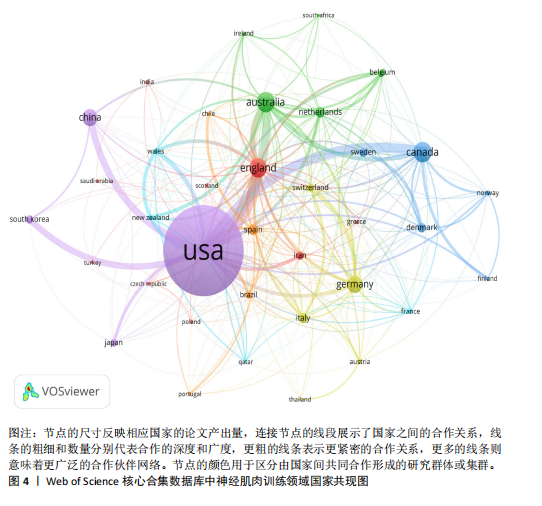
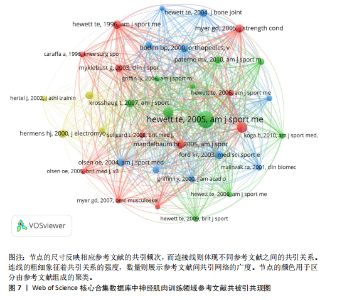
式(#1、#2),该研究热点集中在训练状态、关节症状、肌肉功能、肌肉激活模式等核心关键词;热点3为康复训练方法与应对策略(#3、#5),在康复训练方法与应对策略研究热点中,关键词包括关节病变、损伤风险、关节力矩、前交叉韧带重建、关节肌肉激活等;热点4为风险预防干预与效果实证(#4、#7),该研究热点关注功能性运动筛查、整合神经肌肉训练、热身活动、运动模式等核心关键词。 2.8.3 关键词突现分析 突现分析通过评估关键词在特定时间段内的引用频率来判断研究领域在此期间的活跃程度,并标识出新兴的研究焦点[30-31]。 当关键词的出现频率超过整体数据集的基准阈值时,这类关键词被视为突现词,它们代表着研究前沿并且能够指示研究领域未来的趋势和发展方向[32]。使用citespace软件中“Burstness”功能对20世纪90年代以来的文献进行突现图绘制(图10),共得到28个突现词,分别为deficient knee(膝关节功能障碍)、dynamics(动力学)、contractions(肌肉收缩)、basketball(篮球)、balance (平衡能力)、biomechanics(生物力学)、basketball players(篮球运动员)、anterior cruciate ligament(前交叉韧带)、anterior knee pain(前膝疼痛)、anterior cruciate ligament injury(前交叉韧带损伤)、adolescent soccer players(青少年足球运动员)、 anterior(前侧的)、ankle sprains(踝关节扭伤)、adduction moment(内收力矩)、ankle sprain(踝关节扭伤)、acl reconstruction(前交叉韧带重建)、adaptation(适应)、acute knee injury (急性膝关节损伤)、acl injury(前交叉韧带损伤)、adolescents(青少年)、age (年龄)、ability(能力)、2 dimensional video analysis(二维视频分析)、adjustments(调整)、activation(激活)、adults(成年人)、agility(敏捷性)和ankle(踝关节)。"

| [1] SAÑUDO B, SÁNCHEZ-HERNÁNDEZ J, BERNARDO-FILHO M, et al. Integrative Neuromuscular Training in YoungAthletes, Injury Prevention, and Performance Optimization: A Systematic Review. Appl Sci. 2019;9(18):3839. [2] ARUMUGAM A, BJÖRKLUND M, MIKKO S, et al. Effects of neuromuscular training on knee proprioception in individuals with anterior cruciate ligament injury: a systematic review and GRADE evidence synthesis. BMJ Open. 2021;11(5):e049226. [3] GHADERI M, LETAFATKAR A, THOMAS AC, et al. Effects of a neuromuscular training program using external focus attention cues in male athletes with anterior cruciate ligament reconstruction: a randomized clinical trial. BMC Sports Sci Med Rehabil. 2021;13(1):49. [4] DE SIRE A,DEMECO A,MAROTTA N, et al. Anterior Cruciate Ligament Injury Prevention Exercises: Could a Neuromuscular Warm-Up Improve Muscle Pre-Activation before a Soccer Game? A Proof-of-Principle Study on Professional Football Players. Appl Sci. 2021;11(11):4958. [5] NUNES ACCA, CATTUZZO MT, FAIGENBAUM AD, et al. Effects of Integrative Neuromuscular Training and Detraining on Countermovement Jump Performance in Youth Volleyball Players. J Strength Cond Res. 2021;35(8):2242-2247. [6] VAN MELICK N, VAN CINGEL RE, BROOIJMANS F, et al. Evidence-based clinical practice update: practice guidelines for anterior cruciate ligament rehabilitation based on a systematic review and multidisciplinary consensus. Br J Sports Med. 2016;50(24):1506-1515. [7] SUGIMOTO D, MYER GD, FOSS KD, et al. Specific exercise effects of preventive neuromuscular training intervention on anterior cruciate ligament injury risk reduction in young females: meta-analysis and subgroup analysis. Br J Sports Med. 2015;49(5):282-289. [8] 苏玉莹,彭亮,李卫,等.整合性神经肌肉训练对慢性踝关节不稳康复与预防的研究进展[J].中国体育科技,2023,59(7):47-52. [9] 吴菁,姚英策,杨晓巍,等.肌力训练与神经肌肉电刺激干预髌股关节痛患者下肢功能和生物力学的变化[J].中国组织工程研究, 2024,28(9):1365-1371. [10] CALDEMEYER LE, BROWN SM, MULCAHEY MK. Neuromuscular training for the prevention of ankle sprains in female athletes: a systematic review. Phys Sportsmed. 2020;48(4):363-369. [11] 翟海亭,李成,夏吉祥,等.整合性神经肌肉训练预防下肢运动损伤的元分析[J].中国组织工程研究,2022,26(15):2454-2460. [12] 尹金玲,王松,熊禄全,等.整合性神经肌肉训练对运动员运动表现影响的Meta分析[J].武汉体育学院学报,2021,55(10):77-85. [13] ZHANG J, MI J, LIU R. Effects of integrative neuromuscular training on change of direction performance in court-based sports players: A systematic review and meta-analysis. Int J Sports Sci Coach. 2023; 18(6):2306-2320. [14] WANG P, LIU Y, CHEN C. Effects of neuromuscular training on dynamic balance ability in athletes: A systematic review and meta-analysis. Heliyon. 2024;10(16):e35823. [15] 邱均平.文献计量学的理论、方法和应用[J].图书情报知识, 1984(4):5. [16] 任全娥.大数据背景下的文献计量学研究进展与学科融合[J].情报理论与实践,2019,42(1):48-52. [17] 宋秀芳,迟培娟.Vosviewer与Citespace应用比较研究[J].情报科学,2016,34(7):108-112+146. [18] VAN ECK NJ, WALTMAN L. Software survey: VOSviewer, a computer program for bibliometric mapping. Scientometrics. 2010;84(2): 523-538. [19] CHEN C. CiteSpace II: Detecting and Visualizing Emerging Trendsand Transient Patterns in Scientific Literature. J Am Soc Inf Sci Technol. 2006;57(3):359-377. [20] 张子婷,郑彦宁,袁芳.多指标核心作者识别方法研究[J].现代情报,2020,40(7):144-151. [21] HEWETT TE, MYER GD, FORD KR, et al. Biomechanical measures of neuromuscular control and valgus loading of the knee predict anterior cruciate ligament injury risk in female athletes: a prospective study. Am J Sports Med. 2005;33(4):492-501. [22] HEWETT TE, LINDENFELD TN, RICCOBENE JV, et al. The effect of neuromuscular training on the incidence of knee injury in female athletes. A prospective study. Am J Sports Med. 1999;27(6):699-706. [23] PATERNO MV, SCHMITT LC, FORD KR, et al. Biomechanical measures during landing and postural stability predict second anterior cruciate ligament injury after anterior cruciate ligament reconstruction and return to sport. Am J Sports Med. 2010;38(10):1968-1978. [24] PLISKY PJ, RAUH MJ, KAMINSKI TW, et al. Star Excursion Balance Test as a predictor of lower extremity injury in high school basketball players. J Orthop Sports Phys Ther. 2006;36(12):911-919. [25] HEWETT TE, STROUPE AL, NANCE TA, et al. Plyometric training in female athletes. Decreased impact forces and increased hamstring torques. Am J Sports Med. 1996;24(6):765-773. [26] ZAZULAK BT, HEWETT TE, REEVES NP, et al. Deficits in neuromuscular control of the trunk predict knee injury risk: a prospective biomechanical-epidemiologic study. Am J Sports Med. 2007;35(7): 1123-1130. [27] MANDELBAUM BR, SILVERS HJ, WATANABE DS, et al. Effectiveness of a neuromuscular and proprioceptive training program in preventing anterior cruciate ligament injuries in female athletes: 2-year follow-up. Am J Sports Med. 2005;33(7):1003-1010. [28] ZHAO ML, LU ZJ, YANG L, et al. The cardiovascular system at high altitude: A bibliometric and visualization analysis. World J Cardiol. 2024;16(4):199-214.
[29] 李杰,陈超美.CiteSpace科技文本挖掘及可视化[M].2版.北京:首都经贸大学出版社,2017:97. [30] XU D, WANG YL, WANG KT, et al. A Scientometrics Analysis and Visualization of Depressive Disorder. Curr Neuropharmacol. 2021; 19(6):766-786. [31] YAN W, ZHENG K, WENG L, et al. Bibliometric evaluation of 2000-2019 publications on functional near-infrared spectroscopy. Neuroimage. 2020;220:117121. [32] KIM MC, NAM S, WANG F, et al. Mapping scientific landscapes in UMLS research: a scientometric review. J Am Med Inform Assoc. 2020; 27(10):1612-1624. [33] JIAN C, DENG L, LIANG L, et al. Neuromuscular control of the agonist–antagonist muscle coordination affected by visual dimension: An EMG-fNIRS study. IEEE Access. 2020;8:100768-100777. [34] KWON YU, HARRISON K, KWEON SJ, et al. Ankle Coordination in Chronic Ankle Instability, Coper, and Control Groups in Running. Med Sci Sports Exerc. 2020;52(3):663-672. [35] CONNER BC, SCHWARTZ MH, LERNER ZF. Pilot evaluation of changes in motor control after wearable robotic resistance training in children with cerebral palsy. J Biomech. 2021;126:110601. [36] SUN Y, MUNRO B, ZEHR EP. Compression socks enhance sensory feedback to improve standing balance reactions and reflex control of walking. BMC Sports Sci Med Rehabil. 2021;13(1):61. [37] HOPPER A, HAFF EE, BARLEY OR, et al. Neuromuscular Training Improves Movement Competency and Physical Performance Measures in 11-13-Year-Old Female Netball Athletes. J Strength Cond Res. 2017; 31(5):1165-1176. [38] BENNELL K, HUNTER DJ, VICENZINO B. Long-term effects of sport: preventing and managing OA in the athlete. Nat Rev Rheumatol. 2012; 8(12):747-752. [39] BISCARINI A, CONTEMORI S, GROLLA G. Activation of Scapular and Lumbopelvic Muscles During Core Exercises Executed on a Whole-Body Wobble Board. J Sport Rehabil. 2019;28(6):623-634. [40] BERTH A, PAP G, NEUMAN W, et al. Central neuromuscular dysfunction of the deltoid muscle in patients with chronic rotator cuff tears. J Orthop Traumatol. 2009;10(3):135-141. [41] NAGANO Y, IDA H, AKAI M, et al. Biomechanical characteristics of the knee joint in female athletes during tasks associated with anterior cruciate ligament injury. Knee. 2009;16(2):153-158. [42] CZAMARA A, KRÓLIKOWSKA A. Two-Plane Assessment of Knee Muscles Isometric and Isokinetic Torques After Anterior Cruciate Ligament Reconstruction. Med Sci Monit. 2018;24:4882-4893. [43] MOKHA M, SPRAGUE PA, GATENS DR. Predicting Musculoskeletal Injury in National Collegiate Athletic Association Division II Athletes From Asymmetries and Individual-Test Versus Composite Functional Movement Screen Scores. J Athl Train. 2016;51(4):276-282. [44] HAMMAMI R, NEGRA Y, NEBIGH A, et al. Preseason Integrative Neuromuscular Training Improves Selected Measures of Physical Fitness in Highly Trained, Youth, Male Soccer Players. J Strength Cond Res. 2023;37(6):e384-e390. [45] PREATONI E, FERRARIO M, DONÀ G, et al. Motor variability in sports: a non-linear analysis of race walking. J Sports Sci. 2010;28(12):1327-1336. [46] EASON RG, HOKE J, WHITE CT. Apparatus for measuring neuro-muscular control during rotary tracking. Percept Mot Skills. 1963;17:823-830. [47] DENIER VAN DER GON JJ. Feedback in the neuromuscular control system. Psychiatr Neurol Neurochir. 1968;71(4):301-302. [48] CLARYS JP, CABRI J, BOLLENS E, et al. Muscular activity of different shooting distances, different release techniques, and different performance levels, with and without stabilizers, in target archery. J Sports Sci. 1990;8(3):235-257. [49] SIMARD T. Evaluation of fine neuromuscular control in Duchenne’s progressive muscular dystrophy I. A basic and clinical study in the rehabilitation of 10 non-ambulatory patients. Union Med Can. 1982; 111(6):569-574. [50] WOOLLACOTT M, DEBU B, MOWATT M. Neuromuscular control of posture in the infant and child: is vision dominant? J Mot Behav. 1987; 19(2):167-186. [51] OSTERNIG LR, ROBERTSON RN. Effects of prophylactic knee bracing on lower extremity joint position and muscle activation during running. Am J Sports Med. 1993;21(5):733-737. [52] PELLEGRINI JJ, FLANDERS M. Force path curvature and conserved features of muscle activation. Exp Brain Res. 1996;110(1):80-90. [53] BORSA PA, SAUERS EL, LEPHART SM. Functional training for the restoration of dynamic stability in the PCL-injured knee. J Sport Rehabil. 1999;8(4):362-378. [54] AUGÉ WK 2ND, MORRISON DS. Assessment of the infraspinatus spinal stretch reflex in the normal, athletic, and multidirectionally unstable shoulder. Am J Sports Med. 2000;28(2):206-213. [55] WILLIAMS GN, BARRANCE PJ, SNYDER-MACKLER L, et al. Specificity of muscle action after anterior cruciate ligament injury. J Orthop Res. 2003;21(6):1131-1137. [56] BARBER-WESTIN SD, HERMETO AA, NOYES FR. A six-week neuromuscular training program for competitive junior tennis players. J Strength Cond Res. 2010;24(9):2372-2382. [57] MOESKOPS S, OLIVER JL, RADNOR JM, et al. Effects of Neuromuscular Training on Muscle Architecture, Isometric Force Production, and Stretch-Shortening Cycle Function in Trained Young Female Gymnasts. J Strength Cond Res. 2024;38(9):1640-1650. [58] HEWETT TE, MYER GD, KIEFER AW, et al. Longitudinal Increases in Knee Abduction Moments in Females during Adolescent Growth. Med Sci Sports Exerc. 2015;47(12):2579-2585. [59] NAGANO Y, SAKAGAMI M, IDA H, et al. Statistical modelling of knee valgus during a continuous jump test. Sports Biomech. 2008;7(3):342-350. [60] OSMANSKI-ZENK K, NINGEL A, TISCHER T, et al. Comparative study of postural control in 20-40 years olds and karate athletes using a neuromuscular training device. Sportverletz Sportschaden. 2022; 36(4):200-207. [61] VICO-MORENO E, SASTRE-MUNAR A, FERNÁNDEZ-DOMÍNGUEZ JC, et al. Motor Control and Regularity of Menstrual Cycle in Ankle and Knee Injuries of Female Basketball Players: A Cohort Study. Int J Environ Res Public Health. 2022;19(21):14357. [62] LEHNERT M, BĚLKA J, HŮLKA K, et al. The Landing Biomechanics in Youth Female Handball Players Does Not Change When Applying a Specific Model of Game and Weekly Training Workload. Appl Sci. 2023; 13(23):12847. |
| [1] | Liang Haobo, Wang Zeyu, Ma Wenlong, Liu Hao, Liu Youwen. Hot issues in the field of joint revision: infection, rehabilitation nursing, bone defect, and prosthesis loosening [J]. Chinese Journal of Tissue Engineering Research, 2025, 29(9): 1963-1971. |
| [2] | Lyu Liting, Yu Xia, Zhang Jinmei, Gao Qiaojing, Liu Renfan, Li Meng, Wang Lu. Bibliometric analysis of research process and current situation of brain aging and exosomes [J]. Chinese Journal of Tissue Engineering Research, 2025, 29(7): 1457-1465. |
| [3] | Xie Liugang, Cui Shuke, Guo Nannan, Li Aoyu, Zhang Jingrui. Research hotspots and frontiers of stem cells for Alzheimer’s disease [J]. Chinese Journal of Tissue Engineering Research, 2025, 29(7): 1475-1485. |
| [4] | Chang Jinxia, Liu Yufei, Niu Shaohui, Wang Chang, Cao Jianchun. Visualization analysis of macrophage polarization in tissue repair process [J]. Chinese Journal of Tissue Engineering Research, 2025, 29(7): 1486-1496. |
| [5] | Li Huijun, Li Huangyan, Zhang Yeting. Physical activity and cognition in older adults: research hotspot and topic evolution [J]. Chinese Journal of Tissue Engineering Research, 2025, 29(5): 1073-1080. |
| [6] | Dang Xiaowen, Huang Hailiang, Huang Lei, Wang Yajie . Research frontiers and hotspots of carbon nanomaterials in biomedical field over the past 10 years [J]. Chinese Journal of Tissue Engineering Research, 2025, 29(4): 752-760. |
| [7] | Ma Yucong, Ouyang Zhengzheng, Liu Xiaojie, Yang Sifei. Tracking of research trends and hotspots in medical magnesium alloy materials [J]. Chinese Journal of Tissue Engineering Research, 2025, 29(34): 7470-7480. |
| [8] | Wang Yong, Li Hongyu, Liu Yuhang, Wang Fengxing. Knowledge map of surgical treatment for osteonecrosis of the femoral head: a bibliometric analysis of data from 2005 to 2024 [J]. Chinese Journal of Tissue Engineering Research, 2025, 29(33): 7250-7260. |
| [9] | Deng Qing, Wang Qingjun, Zhang Yeting. Visual analysis of dynamic evolution of research topics in the field of physical activity and hippocampal tissue [J]. Chinese Journal of Tissue Engineering Research, 2025, 29(32): 6997-7003. |
| [10] | Guo Haizhen, Cong Zidong, Zhao Yuke, Li Xiaofeng, Yu Lu, Qian Shule, Wang Runying, Du Wuxun. Development of patch clamp technology in the past 10 years: visual analysis based on CiteSpace and VOSviewer [J]. Chinese Journal of Tissue Engineering Research, 2025, 29(31): 6717-6726. |
| [11] | Zhao Xiaoxuan, Liu Shuaiyi, Xing Zheng, Li Qingwen, Chu Xiaolei, Li Qi. Research hotspots and trends in application of tissue engineering in peripheral nerve injury [J]. Chinese Journal of Tissue Engineering Research, 2025, 29(30): 6591-6600. |
| [12] | Xu Qiang, Qin Jialin, Lian Zeshuang, Wang Aoting, Li Ding, Wang Ye, Wang Junfang. Visual analysis of hot spots and trends in the study of ligamentum flavum ossification [J]. Chinese Journal of Tissue Engineering Research, 2025, 29(3): 628-636. |
| [13] | Zheng Xiaodong, Gao Shan, Han Wenjin, Liu Lijun, Jia Menglong, Yu Longtan. Visual analysis of treatment of adolescent idiopathic scoliosis [J]. Chinese Journal of Tissue Engineering Research, 2025, 29(3): 645-653. |
| [14] | Song Haoran, Zhang Yuqiang, Gu Na, Zhi Xiaodong, Wang Wei. Visualization analysis of artificial intelligence in bone trauma research based on Citespace [J]. Chinese Journal of Tissue Engineering Research, 2025, 29(3): 493-502. |
| [15] | Liu Jian, Liu Qing, Huang Ye, Cao Guanglei, Liu Yuan, Song Qingpeng. Growth factors promote knee cartilage regeneration: a bibliometric analysis of research hotspots [J]. Chinese Journal of Tissue Engineering Research, 2025, 29(29): 6351-6359. |
| Viewed | ||||||
|
Full text |
|
|||||
|
Abstract |
|
|||||
